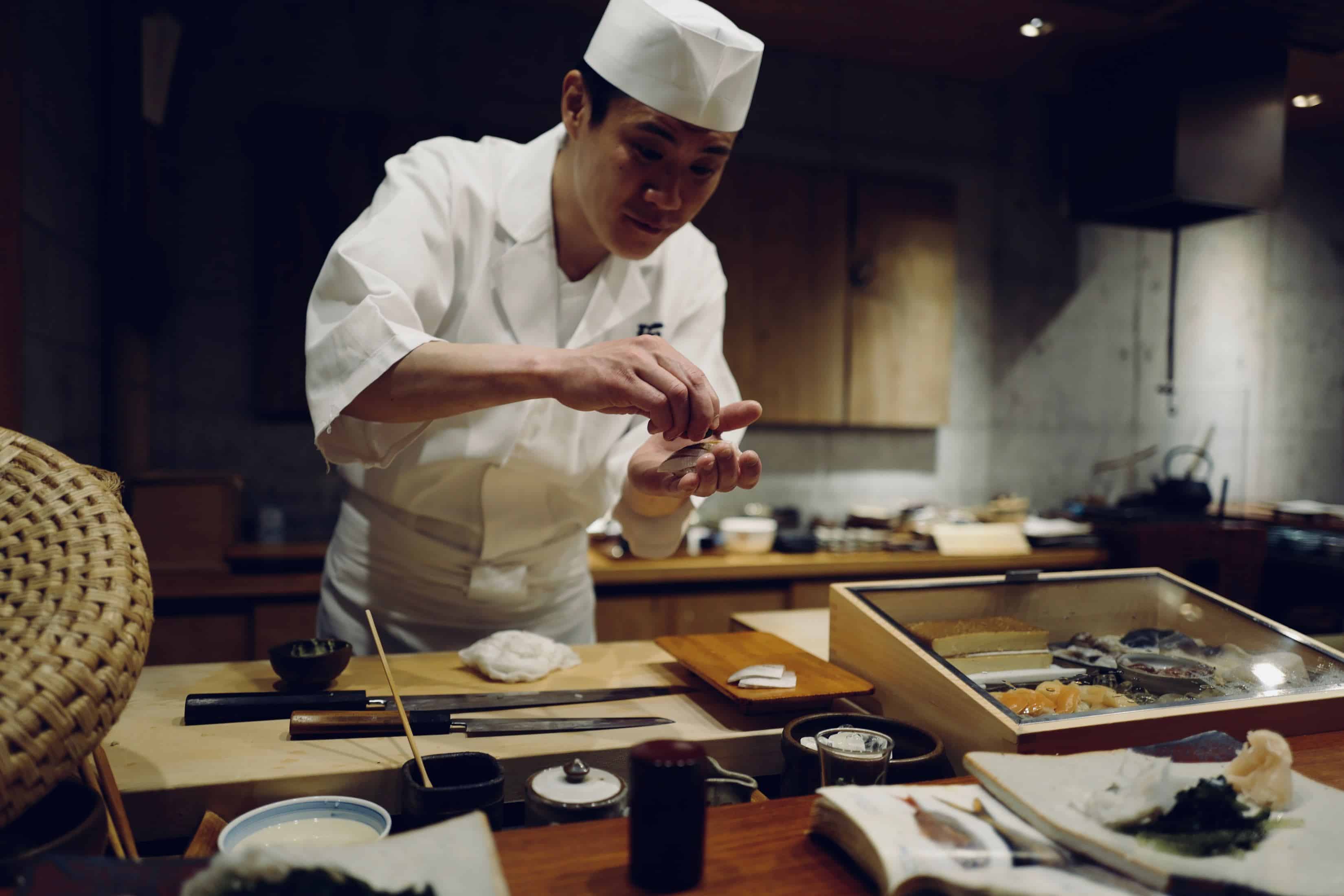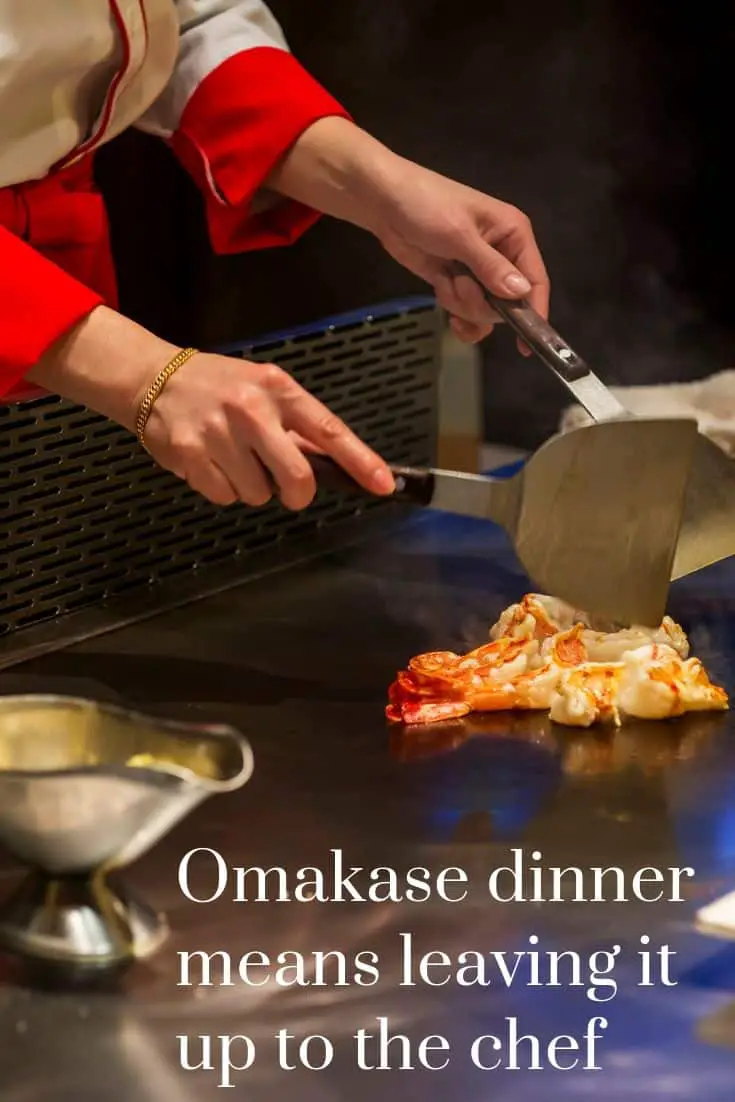What is an omakase dinner? An unforgettable experience!
Have you heard of omakase? Maybe that it’s expensive, but not because it’s luxury dining per se.
Omakase is a Japanese word that means “leaving another to choose what’s best.” In Japan, omakase is a methodically crafted dinner that a sushi chef prepares. It’s often expensive because you’ll find it in fine-dining restaurants.
There are so many reasons why you can have a great time at omakase, so I’m eager to share more about this and what makes it special. Read on!

There’s one thing that makes omakase completely different. Unlike in other restaurants, you can sit at the sushi bar and get an opportunity to interact with the sushi chef.
Seeing the sushi chef showcase their skills can be an unforgettable experience!
The rice reshaping, smooth knife skills, as well as blowtorch skills create a majestic cooking presentation.
In addition to this, the chefs also share interesting recommendations and stories, which make the dining experience more exciting.

Check out our new cookbook
Bitemybun's family recipes with complete meal planner and recipe guide.
Try it out for free with Kindle Unlimited:
Read for freeIn this post we'll cover:
Trust is vital when it comes to omakase
It’s important to note that when it comes to omakase dinner, the essential thing is trust. However, expressing your trust doesn’t mean you don’t care what the sushi chef gives you.
Rather, it tells the chef that you trust their judgment about the recipes they’ll use, what the chef knows about your taste, and the best courses they’d give you at the moment.
Do you like to be more in control yourself? Maybe one of these yakitori grills is perfect for you to start cooking Japanese food yourself.

What’s the main thing about omakase dinner?
Generally, there’s no specific menu when it comes to omakase dinner. Even though the chef might have an idea of the ingredients he’ll use and what will taste good when combined, you’ll never get a specific list.
Every omakase meal is personalized to make it special and unforgettable.
If the sushi chef knows you well, your omakase menu can be a mixture of new dishes and your old favorites. However, your chef must have faith that you’ll enjoy your meal.
If you’ve just met the chef for the first time, then it’s an opportunity for the chef to showcase their talent and skills. Besides, this also allows the chef to give you a unique experience of what they offer!
Complimenting your chef
Some people love sitting quietly around the sushi bar while waiting for the chef to deliver different meals. However, it should never be that way.
If you trust your chef, you should engage them in a conversation as they prepare your omakase dinner. This allows the chef to learn more about you.
The more the chef knows you, the more personalized they can make your meals.
When you come to the end of your omakase dinner, don’t forget to give your chef a heartfelt “thank you“—they’ll always appreciate it.
In addition, you can choose to share a cup of sake with your sushi chef. Your chef will appreciate this more than leaving a tip.
What are the important things you need to know before trying an omakase dinner?
There are 6 things that you need to understand before visiting that restaurant. These things include:
- It doesn’t work everywhere – Not every restaurant will make you enjoy an omakase dinner. It’s important to note that omakase will work best in a restaurant with a supply of fresh ingredients every day. Any restaurant with in-season vegetables or fresh fish will likely offer an excellent omakase dining experience. In addition, your omakase experience can be good, especially if the restaurant practices lots of creativity in its daily menu. Furthermore, you need to note that omakase will never work well in large restaurants, restaurants with a few ingredients, or chain restaurants.
- Make sure you sit close to the chef – If you want to have the ultimate omakase dining experience, make sure that you choose a small restaurant with a viewable kitchen and sushi counter seats. The culture of omakase dining came out of such small and intimate restaurants.
- Understand the language – You need to have good social interaction with your chef if you want your omakase dinner to be memorable. So having the ability to mention some vague Japanese words like “omakase” will make your chef know that you’re into the Japanese culture, which will improve your dining experience.
- Always monitor the air – As highlighted earlier, omakase dinner will require you to give more attention to the chef. At times, your chef will explain every omakase dish to you. In such scenarios, it’s a good thing to remain friendly and avoid asking personal questions. Always ask (use “sumimasen” to interrupt) before taking a photo inside the restaurant. However, it’s not wrong to take a photo of your food. It’s absolutely important to “read the air”. Some restaurant owners and chefs will be more than willing to discuss personal matters with their customers, while others will have a challenge in doing so.
- Get a ticket and enjoy your dinner – Well, omakase is for the adventurous and brave. It might not be ideal for anyone with dietary restrictions, which are likely to crop up. You can’t give your chef restrictions regarding the ingredients they want to use. You can’t ask what you’ll get at the end of the day. Eating the dishes that your chef offers is a gesture of politeness. You should avoid omakase if you’re picky about what you eat.
- You should be ready to pay an unknown price – You’ll receive a non-itemized bill at the end of your meal. You won’t get anything other than a small piece of paper with the total amount you’ve spent. In some scenarios, the drinks won’t be itemized too. In such scenarios, you should avoid asking for a detailed bill. You should understand that a non-detailed bill can’t be expensed.
Many people consider omakase to be a wonderful meal with memorable experiences. So if you want to save money during dinner, then omakase isn’t the ideal way to go.
However, you should understand that you’ll get good value for money here.
Every omakase chef understands that their customers trust them, and they’ll ensure they give you value for what you pay for. Omakase is a gamble that’ll pay off!
What are the rules of omakase dinner?

There’s something that you need to understand if it’s your first time trying out omakase dinner: in case you mess up, then you’re not the first person to do so.
However, it’s important to make a great effort to “do as the Romans do”, or in this case, what the Japanese do. However, some things shouldn’t happen during an omakase dinner. These things are:
- The sushi rice shouldn’t come into contact with the soy sauce – In case you need a splash of soy sauce for your sushi, never let it come into contact with your rice. You should note that rice can soak up a lot of soy sauce, and some chefs can consider this to be insulting to their dish. If the piece is prepared professionally, it won’t need soy sauce.
- You can use your fingers to eat sushi, but you should never eat sashimi with your fingers – If your chef serves you some well-diced toro or another serving without rice, it’s recommendable to use chopsticks. However, if you’re served sushi, you can use your fingers. Since sushi is a bit delicate, it much easier to use your fingers rather than chopsticks.
- Always use ginger to refresh your palate in between dishes, but never add it to your sushi – You should never add ginger to a meal you’ve been given to eat. Otherwise, you might look like you don’t have any appreciation for the flavor your chef has dedicated time to creating.
- Don’t mix wasabi and soy sauce – Professional chefs will put the required amount of wasabi on each piece. Adding some more wasabi would make you look like a clown.
- Always ask for permission before taking any pictures – Some chefs will be ok with you taking photos (here’s how to take the best food photos) of them or their work. However, it’s always a good thing to ask for their permission before taking these photos.
- Never take more than one bite for any sushi piece – Even though you might see other people being served slightly smaller or larger sushi pieces, just know that yours is designed to be the ideal bit for you.
Also read: these are different noodle types you can use
How much does an omakase dinner cost?
The cost of a high-quality omakase dinner in Japan starts at around 10,000 Japanese yen, which works out to around $90.
Omakase isn’t a cheap meal, and this price doesn’t include sake, wine, or any other drink, which can make the price go a bit higher.
It’s not a surprise to spend up to 30,000 Japanese yen or $270 per person on an omakase dinner. So if you’re planning for the ultimate omakase experience, you should be ready to shell out the big bucks!
Have a fantastic culinary experience with omakase
An omakase dinner allows you to enjoy sushi and try out new things, some of which you’ve probably overlooked in your life.
However, you should note that this might not be your meal of choice if you don’t like trying out new things.
But it can brighten your experience, especially if you like learning more about the culture from the stories of the chef.
Also read: the best teppanyaki restaurants in America
Check out our new cookbook
Bitemybun's family recipes with complete meal planner and recipe guide.
Try it out for free with Kindle Unlimited:
Read for freeJoost Nusselder, the founder of Bite My Bun is a content marketer, dad and loves trying out new food with Japanese food at the heart of his passion, and together with his team he's been creating in-depth blog articles since 2016 to help loyal readers with recipes and cooking tips.
